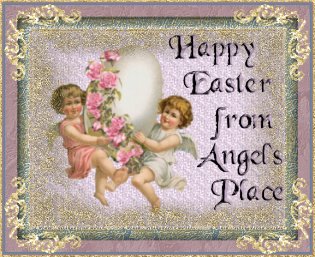
The Story of Easter
Easter, annual festival commemorating the resurrection
of Jesus Christ,and the principal feast of the Christian year.
It is celebrated on a Sunday on varying dates between March 22
and April 25 and is therefore called a movable feast.
The dates of several other ecclesiastical festivals, extending
over a period between Septuagesima Sunday
(the ninth Sunday before Easter) and the first Sunday
of Advent, are fixed in relation to the date of Easter.
Connected with the observance of Easter are the 40-day
penitential season of Lent, beginning on Ash Wednesday and
concluding at midnight on Holy Saturday, the day before
Easter Sunday; Holy Week, commencing on Palm Sunday,
including Good Friday, the day of the crucifixion,
and terminating with Holy Saturday;and the Octave of Easter,
extending from Easter Sunday through the following Sunday.
During the Octave of Easter in early Christian times,
the newly baptized wore white garments, white being the
liturgical color of Easter and signifying light, purity, and joy.
Easter, a Christian festival, embodies many pre-Christian traditions.
The origin of its name is unknown. Scholars, however,
accepting the derivation proposed by the 8th-century English
scholar St. Bede, believe it probably comes from Eastre,
the Anglo-Saxon name of a Teutonic goddess of spring and fertility,
to whom was dedicated a month corresponding to April.
Her festival was celebrated on the day of the vernal equinox;
traditions associated with the festival survive in the Easter rabbit,
a symbol of fertility, and in colored easter eggs, originally painted
with bright colors to represent the sunlight of spring,
and used in Easter-egg rolling contests or given as gifts.
Easter is at the end of the Lenten season, which covers a forty-six-day
period that begins on Ash Wednesday and ends with Easter.
The Lenten season itself comprises forty days, as the six
Sundays in Lent are not actually a part of Lent. Sundays are
considered a commemoration of Easter Sunday and have
always been excluded from the Lenten fast. The Lenten season
is a period of penitence in preparation for the highest
festival of the church year, Easter.
Holy Week, the last week of Lent, begins its with the observance
of Palm Sunday. Palm Sunday takes its name from Jesus'
triumphal entry into Jerusalem where the crowds laid
palms at his feet. Holy Thursday commemorates the Last Supper,
which was held the evening before the Crucifixion.
Friday in Holy Week is the anniversary of the Crufixion,
the day that Christ was crucified and died on the cross
Holy week and the Lenten season end with Easter Sunday,
the day of resurrection of Jesus Christ.

Easter Eggs
Of all the symbols associated with Easter the egg,
the symbol of fertility and new life, is the most identifiable.
The customs and traditions of using eggs have been
associated with Easter for centuries.
Originally Easter eggs were painted with bright colors
to represent the sunlight of spring and were used in
Easter-egg rolling contests or given as gifts.
After they were colored and etched with various
designs the eggs were exchanged by lovers and
romantic admirers, much the same as valentines.
In medieval time eggs were traditionally given at Easter
to the servants. In Germany eggs were given to
children along with other Easter gifts.
Different cultures have developed their own ways of
decorating Easter eggs. Crimson eggs, to honor the
blood of Christ, are exchanged in Greece. In parts of
Germany and Austria green eggs are used on Maundy Thursday
(Holy Thursday). Slavic peoples decorate their eggs in special
patterns of gold and silver.
Austrian artists design patterns by fastening ferns and tiny
plants around the eggs, which are then boiled. The plants
are then removed revealing a striking white pattern.
The Poles and Ukrainians decorate eggs with simple designs
and colors. A number of eggs are made in the distinctive
manner called pysanki (to design, to write).
Pysanki eggs are a masterpiece of skill and workmanship.
Melted beeswax is applied to the fresh white egg.
It is then dipped in successive baths of dye. After each dip
wax is painted over the area where the preceding color
is to remain. Eventually a complex pattern of lines
and colors emerges into a work of art.
In Germany and other countries eggs used for cooking
where not broken, but the contents were removed by piercing
the end of each egg with a needle and blowing the contents
into a bowl. The hollow eggs were died and hung from shrubs
and trees during the Easter Week. The Armenians would
decorate hollow eggs with pictures of Christ,
the Virgin Mary, and other religious designs.

The Easter Bunny
The Easter bunny has its origin in pre-Christian fertility lore.
The Hare and the Rabbit were the most fertile animals
known and they served as symbols of the new life
during the Spring season.
The bunny as an Easter symbol seems to have it's origins in
Germany, where it was first mentioned in German writings in the
1500s. The first edible Easter bunnies were made in Germany
during the early 1800s, and were made of pastry and sugar.
The Easter bunny was introduced to American folklore
by the German settlers who arrived in the Pennsylvania Dutch
country during the 1700s. The arrival of the "Oschter Haws"
was considered "childhood's greatest pleasure" next to a visit from
Christ-Kindel on Christmas Eve. The children believed that if they
were good the "Oschter Haws" would lay a nest of colored eggs.
The children would build their nest in a secluded place in the home,
the barn or the garden. Boys would use their caps and girls
their bonnets to make the nests . The use of elaborate Easter
baskets would come later as the tradition of the Easter
bunny spread through out the country.

 
 
 


Graphics made by HoneysAngel. Please do no use without permission.
|